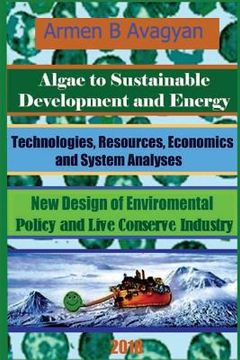Share
Algae to Energy and Sustainable Development. Technologies, Resources, Economics and System analyses. New Design of Global Environmental Policy and Liv
Armen B. Avagyan
(Author)
·
Createspace Independent Publishing Platform
· Paperback
Algae to Energy and Sustainable Development. Technologies, Resources, Economics and System analyses. New Design of Global Environmental Policy and Liv - Avagyan, Armen B.
Choose the list to add your product or create one New List
✓ Product added successfully to the Wishlist.
Go to My Wishlists
Origin: U.S.A.
(Import costs included in the price)
It will be shipped from our warehouse between
Monday, July 22 and
Wednesday, August 07.
You will receive it anywhere in United Kingdom between 1 and 3 business days after shipment.
Synopsis "Algae to Energy and Sustainable Development. Technologies, Resources, Economics and System analyses. New Design of Global Environmental Policy and Liv"
The book is devoted to the current problem of global sustainable development; conflicts with the effective system working that allow making some conclusion for further compatibility improvements. At foremost, analyses look at recent international and own researchers dealing with algae technology and conversation to energy. The total global production of macroalgae is superior about 100 times compared to microalgae or 19 - 23 million tons by dry weight and market at $5 - 6 billion. Macroalgal biomass has a potential for the production of biofuels and can be used also for decentralized wastewater cleaning. The analyses showed that development microalgae producing have all necessary unlimited resources such as land and water (wastewater and groundwater). Food waste use for microalgae cultivation can lead to GHG mitigation up to 3.3 GTCO2e/yr or 8 % of global emissions. The UNEP ignored high carbon capture and storage (CCS) potential of algae. Simultaneously, international organization and researchers as main constraints for microalgae biofuels have described the cost of their production based on comparing with prices of oil fuels and crop biofuels. Comparison of the cost of microalgal biofuel production with a subsided prices of oil and crops biofuel is a methodical mistake as the governments have paid part of their fuel price from public funds as well as it is necessary to take into account also large scale production competitive benefits. It is stressed that many projects and Life Cycle Assessments (LCAs) are based on using fertilizers for nutrition microalgae. According to the ISO/TS 14067, we estimated day input of including fertilizers with nitrogen content in the total emissions of the product full life cycle by expanding of LCA boundary. Calculation emission by the use of last U.S. NPEL design of microalgae to biofuel showed that only used fertilizers with nitrogen content for the day microalgae biomass production release CO2 emission 63.56 kgCO2e per kg of the produced microalgae biomass. This is more that impact of CCS by algae cultivation - 1.83 kgCO2e per kg of algal biomass, gasoline and diesel emissions by combustion in motor vehicles (gasoline is realized 2.29 kgCO2/L (E10 - 2.21 and E85 - 1.61 kgCO2/L ) and diesel - 2.66 kgCO2/L (B5 - 2.65 and B20 - 2.62 kgCO2/L)) as well as sum of crude oils extraction-to-refining (4 to 50 gCO2e/megajoule (MJ) (about half of the total EU plants has extraction-to-refining emission from 4 to 9 gCO2/MJ) and combustion in motor vehicle emissions of 73 gCO2e/MJ). This proves that phototrophic growth of microalgae has no perspective for commercial production. The additional stressed issue is that in 2016, biofuel crops boost fertilizer industry and nitrogen fertilizer consumption intended to biofuels production. Therefore, it offered that first generation biofuel producers should seriously think about the use of feedstock yields originated by the use of organic agriculture approach. As a result of system analyses, it made the conclusion that sole main barrier for realizing of algae biofuel potential is ineffective international and governmental policies which create difficulties in the coupling of the goals between economic development and environmental activity. Therefore, we offered the new design of environmental police and relevant innovative financial mechanisms in a framework of Public/Private Partnership for archiving of effective investment flow to mitigation pollution. This policy based on recognizing of Life Conserve industry as the separate branch of production and each company which activity direct or indirect decrease pollution must receive payment for the impact of their products. Simultaneously, the analysis provides that near-term microalgae come to big feed additives market as feed additives for animals and for the fishmeal replacement in aquaculture due to competitive cost archived by technological advancement and benefits of their content.
- 0% (0)
- 0% (0)
- 0% (0)
- 0% (0)
- 0% (0)
All books in our catalog are Original.
The book is written in English.
The binding of this edition is Paperback.
✓ Producto agregado correctamente al carro, Ir a Pagar.

